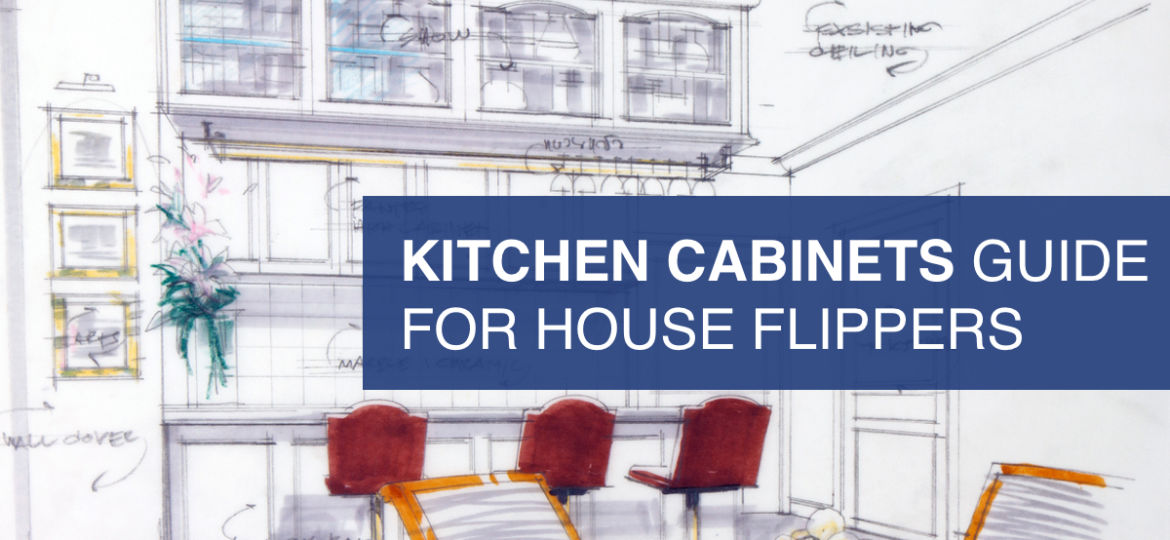
Kitchen Cabinets Guide for House Flippers
We all know that there is no better way to make money than to take matters into your own hands and create your own opportunity. Instead of riding the wave of the economy, hoping someone will hire you at the wage you desire, more and more people are becoming property investors and taking on a certain amount of calculated risk to give themselves a more secure future. This is an awesome time to be a property investor since the ability to source both material and labor has been revolutionized. You are no longer stuck with whatever the big box stores or some paper catalogs have to offer. You can take to the web and find beautiful and durable home finishes that allow you to maximize your house flipping budget. This is particularly true when it comes to buying new cabinets for your next REI project.

Kitchen cabinets can easily end up being the single most expensive feature in a large kitchen renovation of a house flip. Since they will be a large feature at eye level, they are also the largest signifier to the prospective home buyer that quality went into this home. The first room most of your prospects will gravitate to is the kitchen, and even when the agent is done showing off the home, they are likely to come back to the kitchen and use it as a place to talk with the prospective buyer about what they like and do not like. Needless to say, it would be great to have a kitchen capable of sealing the deal.
With kitchens being the most important room in the home, choosing the right cabinets can be a make-or-break decision. It is important to get the best kitchen cabinets possible while remaining on budget, or under! That may sound like a tall task, but it is very do-able, even for a first-time house flipper. Knowing what to buy and where to buy it is key. Today’s blog post will help you with that!
Custom, Pre-Fabricated, High-End, or Stock Cabinets?
Custom Cabinets: $$$
From design to construction, a custom cabinet takes all your individual wants and needs into consideration. You can choose the cabinets size, finish, material, and any other special features. You might consider hiring a kitchen designer if the project is big or you don’t have very good design skills. Once all the particulars are sorted out, the cabinets are hand crafted and delivered to you. This type of cabinet has the widest range of total cost because it is only limited by your imagination and budget.
Stock Cabinets: $ + Labor
There are other companies who make stock cabinets, but the industry is pretty much dominated by IKEA, followed by a bunch of smaller shops. IKEA is the industry standard, and given their scale, it is hard to beat them on price, options, and availability. Stock cabinets are made of very low-cost materials and shipped flat. You must assemble them. This means the products are very affordable but the labor cost or DIY effort on your part will have to come into play later.
Pre-Fabricated Cabinets: $$
Going prefab means choosing to shop from everybody’s favorite big box stores like Home Depot and Lowes. They offer a set of options like IKEAs, but they also assemble the cabinets so that all you must do is install them once they are delivered to your project site. These cabinets are usually made of better materials than the IKEA stock cabinets, but they also cost more. Still, you are saving money and time on labor since they are pre-assembled.
High-End Cabinets: $$$$
There is a small pool of cabinet makers that sell cabinet systems on the very upper end of the market. These are all intended for high-dollar homes since the average cabinet project they work on is in the tens of thousands of dollars. Modernstile.com is one prominent example.
Custom Cabinets are Not Always Expensive
If your kitchen’s dimensions do not fit well with prefab or stock cabinetry, a custom cabinet solution may be more economical. If you need lots of modifications to make the standard cabinet fit, then a custom cabinet can be made to the exact specifications of the kitchen so all they need is installation. This goes for kitchens large or small. A very tiny NYC or San Francisco condo may not allow for the usual pre-assembled cabinet. A home with a very unique layout that features abnormally large spaces or lots of corners at odd angles will probably be better served by cabinets custom designed to suit it best.
Custom Cabinets are Not for the Starter Home
 If you are flipping on the lower end to lower-middle of the market, you are not well served by choosing very bold and expensive features. They will eat up your budget and have the home at serious risk for being too expensive for the market. Not to mention that it is also likely that the first buyer will leave that home within a decade or less when styles have changed, and a certain amount of wear and tear makes doing some new work to the kitchen more likely. Homeowners at the lower end of the market tend to be harder on their homes and spend less on upkeep throughout the years. It is best to make choices for this market that are stylish and reasonably durable, yet economical.
If you are flipping on the lower end to lower-middle of the market, you are not well served by choosing very bold and expensive features. They will eat up your budget and have the home at serious risk for being too expensive for the market. Not to mention that it is also likely that the first buyer will leave that home within a decade or less when styles have changed, and a certain amount of wear and tear makes doing some new work to the kitchen more likely. Homeowners at the lower end of the market tend to be harder on their homes and spend less on upkeep throughout the years. It is best to make choices for this market that are stylish and reasonably durable, yet economical.
For homes in the middle and upper tiers of the market, semi-custom and fully custom cabinets have very high-quality materials that are as durable as they are attractive. Furthermore, this market tends to spend money on maintaining their homes, so a little extra money spent on these homes is more appreciated.
Materials, Hardware, and Installation Tips
Two very common stock cabinet materials particle board and MDF do not stand up to water, friction, or impacts with hard objects very well. Even plywood will be stronger and last longer than these materials. Solid wood will remain in great shape even longer. Do not forget about how the sides of the cabinets are joined. Custom cabinets tend to use joinery methods that more evenly distribute weight throughout a wide area, versus stock cabinets which are joined by bolts and nails which must support weight at just a few small points. Those points are inherent weaknesses in the cabinet which over time will likely become breaking points. Extra features like strong hinges and dampeners that slow the doors down near the point of close or near the point of total open tend to be standard with custom cabinets, not so much with stock and pre-fabricated cabinets.
Also, those custom cabinet makers are very proud of their products, are serving a higher-paying clientele, and don’t work with a high volume of calls, so they tend to be very responsive to your customer service needs.
So, when you factor in assembly, some need for customization, and installation, it is possible for an IKEA cabinet set to not be much less expensive than a custom one. If you can make room for it elsewhere in your house flip budget, you may be able to justify spending a few more thousand dollars in the kitchen on better cabinetry.
Benefits of Pre-Fab Cabinets
If your flip is on a very tight schedule or if you feel intimidated by your first flip, then it is sensible to go for what is already in stock and save your mental stamina for things that are unavoidable. Custom cabinets will require time. Some pre-fabs can be ready the same day. The most they will take is a few weeks.
**Pro Tip: Combine Stock or Prefabricated Cabinets with Custom Pieces**
If you combine the off the shelf cabinets with some custom pieces, you may get the best of both worlds. A kitchen that is affordable but unique. There are even some companies who specialize in customizing IKEA cabinets. Their modifications are both aesthetic and structural.
Give Your Kitchen Cabinets a Makeover
The easiest and cheapest thing you can do is simply reface some old, existing cabinets in the home. If they are structurally sound but a little dated or worn, a new door, stain, or coat of paint might do the trick. You can even add other features like the dampener for very little money and just a bit of your time.
Kitchen Cabinet Reno Strategies
The cabinets are, of course, not your only concern. You will need somebody to install them. Just how much labor and cost will go into this varies greatly on what you plan to do with the kitchen and the type of cabinets you choose. There are four kitchen cabinet strategies that demand a unique delegation of labor.
Touch Up:
If you are simply replacing some finishes, applying a new stain to old wood, and are going to be making all the design choices yourself, then all you need is a general contractor to install the cabinets. This is great for a starter home project in an area that won’t allow for a high home price. This arrangement keeps costs low.
Minor Upgrade:
If you do want some light professional assistance with changing the layout of the kitchen cabinets, but really are more concerned with having professional help on choosing things like color, material, style, etc. then you will need an interior designer and a general contractor.
Modernizing:
Will your new kitchen cabinet assembly require major changes to the structure in a very old home? Maybe even a home that is considered a historical landmark that requires a certain procedure to be followed. Do you need to have a gas line added? In this case, you need an architect along with a general contractor, and maybe even a few specialists to play their part.
Ambitious:
If you are trying to radically change the layout of the building and how people use the kitchen, even how they enter and exit it, then you will most likely need the services of an architect, an interior designer, and a general contractor. Taking a tiny kitchen with an electric stove and knocking down two of the walls around it to claim more space for it while adding a gas range with an advanced ventilation system will require the efforts of all kinds of professionals at various points. Depending on your city or municipality, you may need someone adept at getting approvals for changes. Breaking everything down and starting from scratch is going to require a keen design eye, and to get all of this done on schedule and at budget, someone is going to need to function as a project manager. A general contractor who can manage the execution phase is crucial because you may not yet have the experience to know what timetables and costs are normal. They do, and can act quickly when things appear to be going off the rails.

